Exploring Human Resource Management and Performance
VerifiedAdded on 2019/12/18
|13
|3788
|256
Essay
AI Summary
The provided content, a collection of academic articles and books on human resource management and performance, explores various topics such as the economics of human development and social mobility, environmental management and operational performance, high-performance human resource practices, dynamic managerial capabilities, goal setting and task performance, positive psychological capital, entrepreneurship education outcomes, management teams, green human resource management, and situational judgment tests. The articles discuss how these concepts can impact employee attitudes and behaviors, organizational performance, and individual development across cultures.
Contribute Materials
Your contribution can guide someone’s learning journey. Share your
documents today.
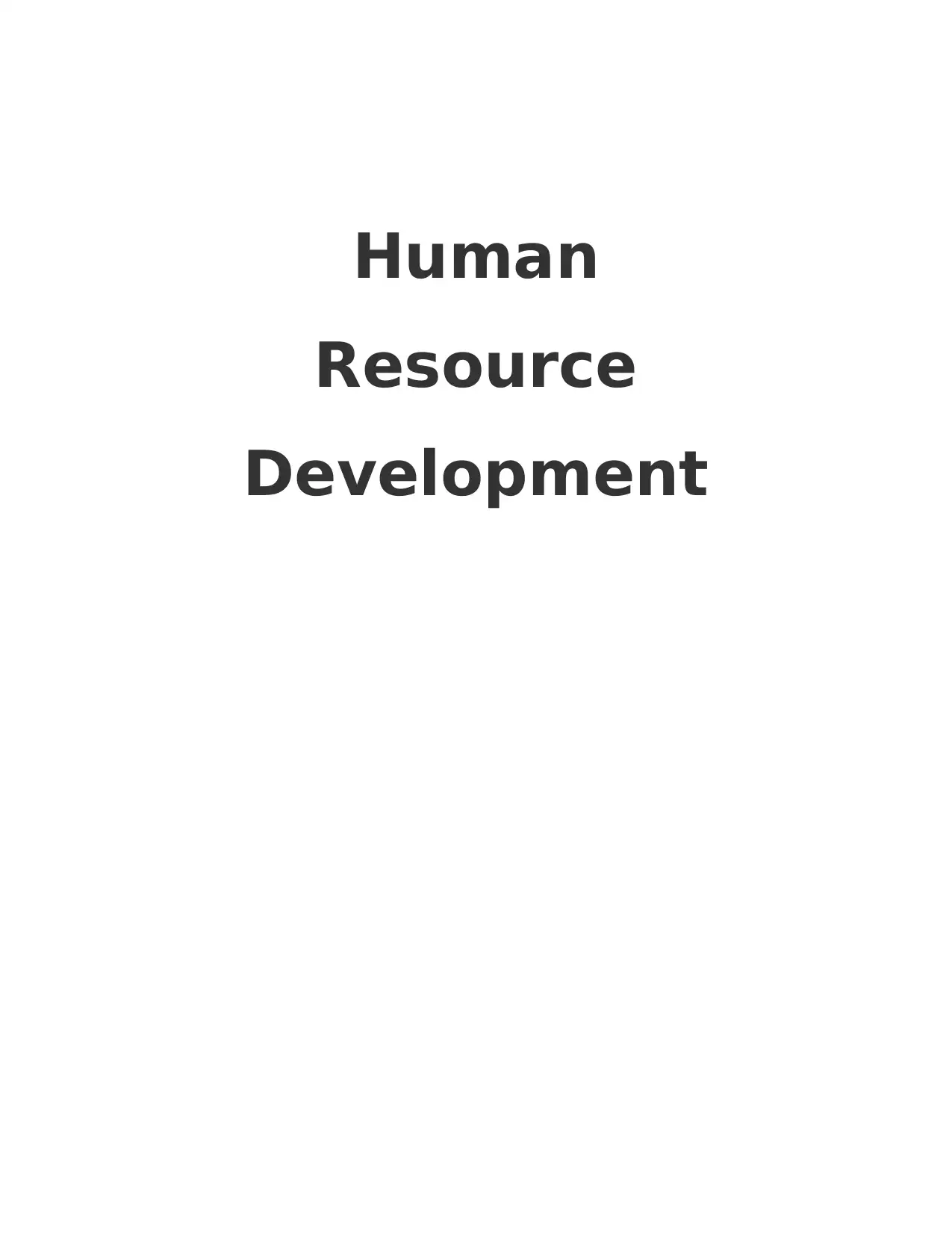
Human
Resource
Development
Resource
Development
Secure Best Marks with AI Grader
Need help grading? Try our AI Grader for instant feedback on your assignments.
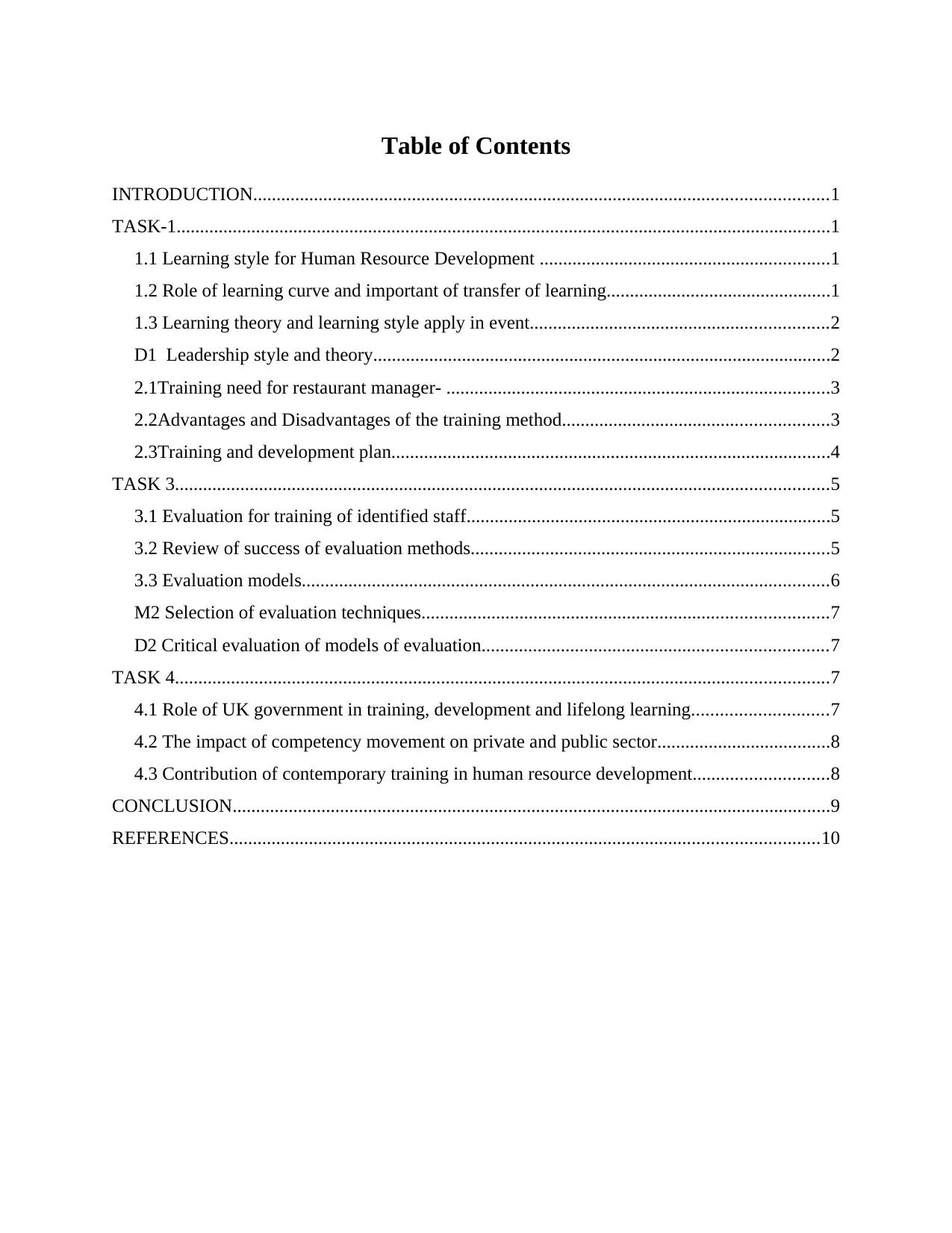
Table of Contents
INTRODUCTION...........................................................................................................................1
TASK-1............................................................................................................................................1
1.1 Learning style for Human Resource Development ..............................................................1
1.2 Role of learning curve and important of transfer of learning................................................1
1.3 Learning theory and learning style apply in event................................................................2
D1 Leadership style and theory..................................................................................................2
2.1Training need for restaurant manager- ..................................................................................3
2.2Advantages and Disadvantages of the training method.........................................................3
2.3Training and development plan..............................................................................................4
TASK 3............................................................................................................................................5
3.1 Evaluation for training of identified staff..............................................................................5
3.2 Review of success of evaluation methods.............................................................................5
3.3 Evaluation models.................................................................................................................6
M2 Selection of evaluation techniques.......................................................................................7
D2 Critical evaluation of models of evaluation..........................................................................7
TASK 4............................................................................................................................................7
4.1 Role of UK government in training, development and lifelong learning.............................7
4.2 The impact of competency movement on private and public sector.....................................8
4.3 Contribution of contemporary training in human resource development.............................8
CONCLUSION................................................................................................................................9
REFERENCES..............................................................................................................................10
INTRODUCTION...........................................................................................................................1
TASK-1............................................................................................................................................1
1.1 Learning style for Human Resource Development ..............................................................1
1.2 Role of learning curve and important of transfer of learning................................................1
1.3 Learning theory and learning style apply in event................................................................2
D1 Leadership style and theory..................................................................................................2
2.1Training need for restaurant manager- ..................................................................................3
2.2Advantages and Disadvantages of the training method.........................................................3
2.3Training and development plan..............................................................................................4
TASK 3............................................................................................................................................5
3.1 Evaluation for training of identified staff..............................................................................5
3.2 Review of success of evaluation methods.............................................................................5
3.3 Evaluation models.................................................................................................................6
M2 Selection of evaluation techniques.......................................................................................7
D2 Critical evaluation of models of evaluation..........................................................................7
TASK 4............................................................................................................................................7
4.1 Role of UK government in training, development and lifelong learning.............................7
4.2 The impact of competency movement on private and public sector.....................................8
4.3 Contribution of contemporary training in human resource development.............................8
CONCLUSION................................................................................................................................9
REFERENCES..............................................................................................................................10
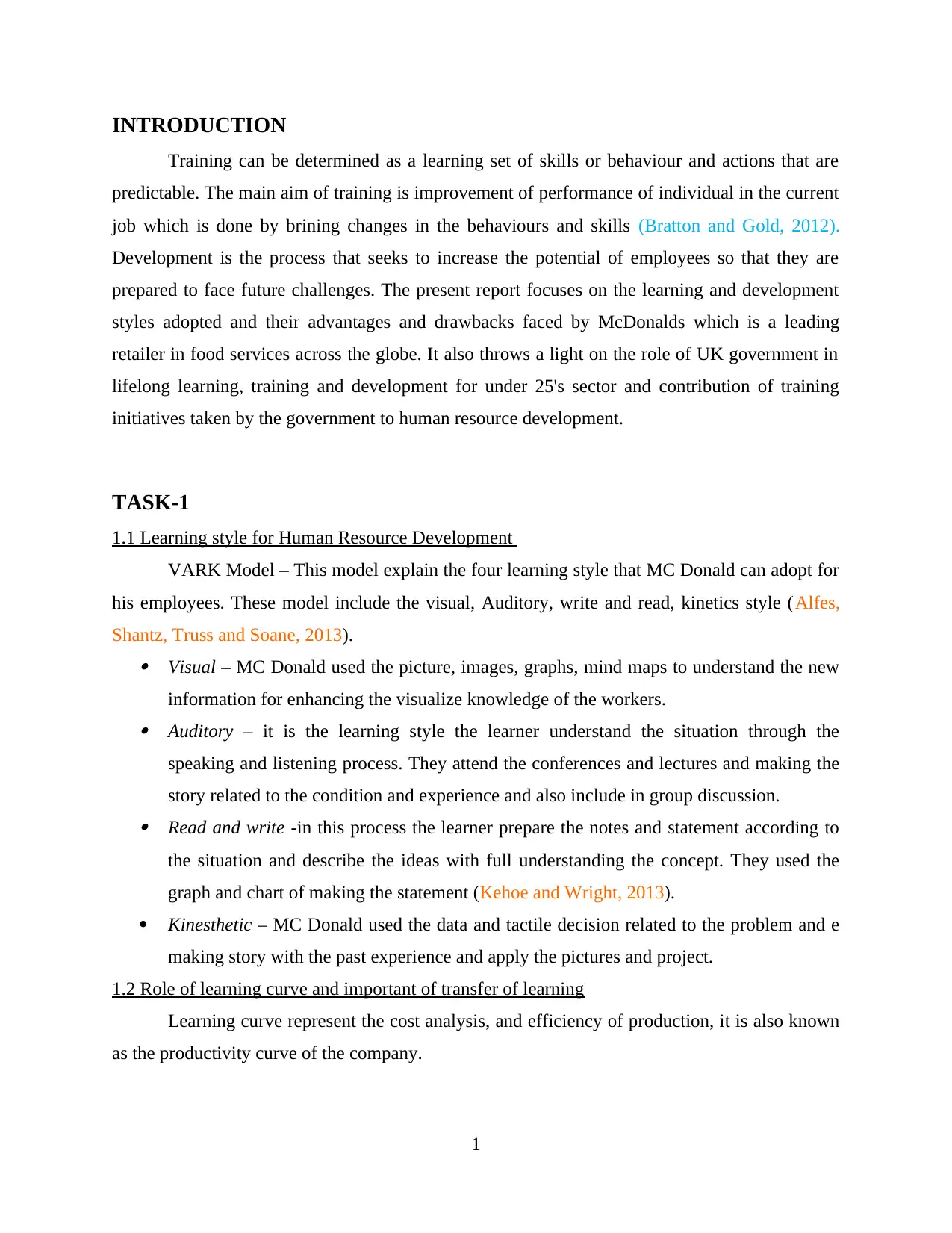
INTRODUCTION
Training can be determined as a learning set of skills or behaviour and actions that are
predictable. The main aim of training is improvement of performance of individual in the current
job which is done by brining changes in the behaviours and skills (Bratton and Gold, 2012).
Development is the process that seeks to increase the potential of employees so that they are
prepared to face future challenges. The present report focuses on the learning and development
styles adopted and their advantages and drawbacks faced by McDonalds which is a leading
retailer in food services across the globe. It also throws a light on the role of UK government in
lifelong learning, training and development for under 25's sector and contribution of training
initiatives taken by the government to human resource development.
TASK-1
1.1 Learning style for Human Resource Development
VARK Model – This model explain the four learning style that MC Donald can adopt for
his employees. These model include the visual, Auditory, write and read, kinetics style (Alfes,
Shantz, Truss and Soane, 2013). Visual – MC Donald used the picture, images, graphs, mind maps to understand the new
information for enhancing the visualize knowledge of the workers. Auditory – it is the learning style the learner understand the situation through the
speaking and listening process. They attend the conferences and lectures and making the
story related to the condition and experience and also include in group discussion. Read and write -in this process the learner prepare the notes and statement according to
the situation and describe the ideas with full understanding the concept. They used the
graph and chart of making the statement (Kehoe and Wright, 2013).
Kinesthetic – MC Donald used the data and tactile decision related to the problem and e
making story with the past experience and apply the pictures and project.
1.2 Role of learning curve and important of transfer of learning
Learning curve represent the cost analysis, and efficiency of production, it is also known
as the productivity curve of the company.
1
Training can be determined as a learning set of skills or behaviour and actions that are
predictable. The main aim of training is improvement of performance of individual in the current
job which is done by brining changes in the behaviours and skills (Bratton and Gold, 2012).
Development is the process that seeks to increase the potential of employees so that they are
prepared to face future challenges. The present report focuses on the learning and development
styles adopted and their advantages and drawbacks faced by McDonalds which is a leading
retailer in food services across the globe. It also throws a light on the role of UK government in
lifelong learning, training and development for under 25's sector and contribution of training
initiatives taken by the government to human resource development.
TASK-1
1.1 Learning style for Human Resource Development
VARK Model – This model explain the four learning style that MC Donald can adopt for
his employees. These model include the visual, Auditory, write and read, kinetics style (Alfes,
Shantz, Truss and Soane, 2013). Visual – MC Donald used the picture, images, graphs, mind maps to understand the new
information for enhancing the visualize knowledge of the workers. Auditory – it is the learning style the learner understand the situation through the
speaking and listening process. They attend the conferences and lectures and making the
story related to the condition and experience and also include in group discussion. Read and write -in this process the learner prepare the notes and statement according to
the situation and describe the ideas with full understanding the concept. They used the
graph and chart of making the statement (Kehoe and Wright, 2013).
Kinesthetic – MC Donald used the data and tactile decision related to the problem and e
making story with the past experience and apply the pictures and project.
1.2 Role of learning curve and important of transfer of learning
Learning curve represent the cost analysis, and efficiency of production, it is also known
as the productivity curve of the company.
1

(1) Role of learning Curve – This curve help to MC Donald to identifying the need, demand
and preferences of the consumers. The price and future estimation of budget and
requirement of human resources in the company .It set up the bonus and incentive policy
and plan for the employees. It analysis the present, past data and help in take right
decision for the future.
(2) Importance of transfer of learning- Its essential where we apply the new techniques in the
business for generating the profit. MC Donald Increase the productivity of the firm and
efficiency of the employees for the motivating the people. It help to maintain the
mentally discipline and interest of the person for generating the new creative and
innovative idea for maintaining the relation between consumer and employees in the
business (Dries, 2013).
1.3 Learning theory and learning style apply in event
MC Donald organized a conference the contribution of learning theory and learning style these
are follow -
They used the behavioural theory for the leaning of the employees. It focus on the goal
objectives and behaviour of the person and dependency on the quantity and quality (Martin,
McNally and Kay, 2013). It relate the four factors like-knowledge, view of learning, motivation,
implication of teaching in the conferences. MC Donald used the learning through the statement
and prepare the training module for the workers. MC Donald used the motivation for enhancing
the efficiency of employees.
Kolb learning style used by the MC Donald in the organizing conference according to this they
consist the four elements it is all over depend on the experience according to this they prefer the
doing the work and get the knowledge and also analysis and reviewed this technique, implement
the training and give the suggestion to the solution of the problem (Heckman and Mosso, 2014).
D1 Leadership style and theory
According to above discussion preparing the training module for the fulfilling the goal and
objective of the business .they select the visual and kinaesthetic style.
MC Donald used the visual for the training because this is the way the learner learn through the
writing, reading and observing the thing. They used the more videos, graph, charts and creating
the innovative story so that they understand the position in the mind (Kor and Mesko, 2013).
2
and preferences of the consumers. The price and future estimation of budget and
requirement of human resources in the company .It set up the bonus and incentive policy
and plan for the employees. It analysis the present, past data and help in take right
decision for the future.
(2) Importance of transfer of learning- Its essential where we apply the new techniques in the
business for generating the profit. MC Donald Increase the productivity of the firm and
efficiency of the employees for the motivating the people. It help to maintain the
mentally discipline and interest of the person for generating the new creative and
innovative idea for maintaining the relation between consumer and employees in the
business (Dries, 2013).
1.3 Learning theory and learning style apply in event
MC Donald organized a conference the contribution of learning theory and learning style these
are follow -
They used the behavioural theory for the leaning of the employees. It focus on the goal
objectives and behaviour of the person and dependency on the quantity and quality (Martin,
McNally and Kay, 2013). It relate the four factors like-knowledge, view of learning, motivation,
implication of teaching in the conferences. MC Donald used the learning through the statement
and prepare the training module for the workers. MC Donald used the motivation for enhancing
the efficiency of employees.
Kolb learning style used by the MC Donald in the organizing conference according to this they
consist the four elements it is all over depend on the experience according to this they prefer the
doing the work and get the knowledge and also analysis and reviewed this technique, implement
the training and give the suggestion to the solution of the problem (Heckman and Mosso, 2014).
D1 Leadership style and theory
According to above discussion preparing the training module for the fulfilling the goal and
objective of the business .they select the visual and kinaesthetic style.
MC Donald used the visual for the training because this is the way the learner learn through the
writing, reading and observing the thing. They used the more videos, graph, charts and creating
the innovative story so that they understand the position in the mind (Kor and Mesko, 2013).
2
Secure Best Marks with AI Grader
Need help grading? Try our AI Grader for instant feedback on your assignments.
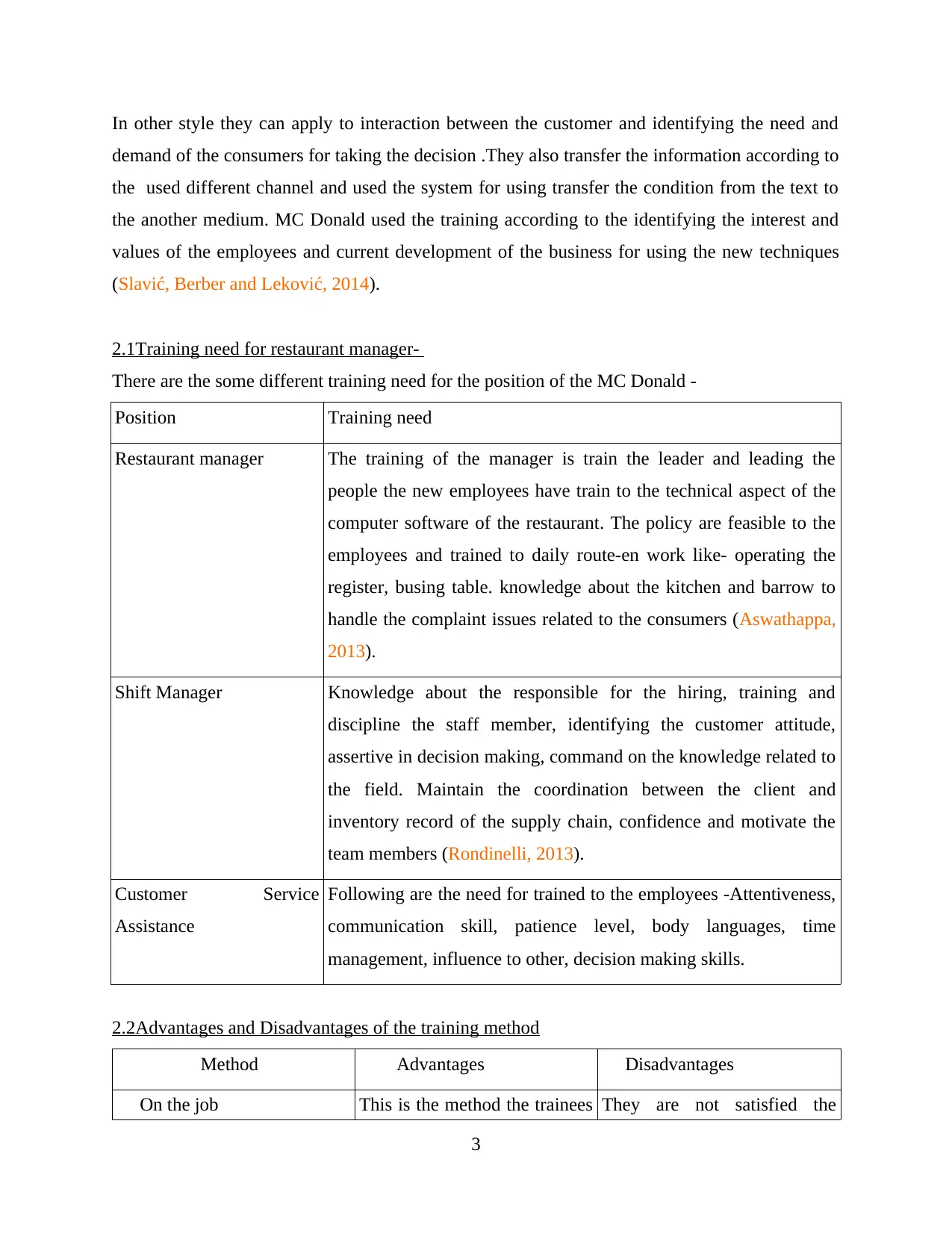
In other style they can apply to interaction between the customer and identifying the need and
demand of the consumers for taking the decision .They also transfer the information according to
the used different channel and used the system for using transfer the condition from the text to
the another medium. MC Donald used the training according to the identifying the interest and
values of the employees and current development of the business for using the new techniques
(Slavić, Berber and Leković, 2014).
2.1Training need for restaurant manager-
There are the some different training need for the position of the MC Donald -
Position Training need
Restaurant manager The training of the manager is train the leader and leading the
people the new employees have train to the technical aspect of the
computer software of the restaurant. The policy are feasible to the
employees and trained to daily route-en work like- operating the
register, busing table. knowledge about the kitchen and barrow to
handle the complaint issues related to the consumers (Aswathappa,
2013).
Shift Manager Knowledge about the responsible for the hiring, training and
discipline the staff member, identifying the customer attitude,
assertive in decision making, command on the knowledge related to
the field. Maintain the coordination between the client and
inventory record of the supply chain, confidence and motivate the
team members (Rondinelli, 2013).
Customer Service
Assistance
Following are the need for trained to the employees -Attentiveness,
communication skill, patience level, body languages, time
management, influence to other, decision making skills.
2.2Advantages and Disadvantages of the training method
Method Advantages Disadvantages
On the job This is the method the trainees They are not satisfied the
3
demand of the consumers for taking the decision .They also transfer the information according to
the used different channel and used the system for using transfer the condition from the text to
the another medium. MC Donald used the training according to the identifying the interest and
values of the employees and current development of the business for using the new techniques
(Slavić, Berber and Leković, 2014).
2.1Training need for restaurant manager-
There are the some different training need for the position of the MC Donald -
Position Training need
Restaurant manager The training of the manager is train the leader and leading the
people the new employees have train to the technical aspect of the
computer software of the restaurant. The policy are feasible to the
employees and trained to daily route-en work like- operating the
register, busing table. knowledge about the kitchen and barrow to
handle the complaint issues related to the consumers (Aswathappa,
2013).
Shift Manager Knowledge about the responsible for the hiring, training and
discipline the staff member, identifying the customer attitude,
assertive in decision making, command on the knowledge related to
the field. Maintain the coordination between the client and
inventory record of the supply chain, confidence and motivate the
team members (Rondinelli, 2013).
Customer Service
Assistance
Following are the need for trained to the employees -Attentiveness,
communication skill, patience level, body languages, time
management, influence to other, decision making skills.
2.2Advantages and Disadvantages of the training method
Method Advantages Disadvantages
On the job This is the method the trainees They are not satisfied the
3

place the job and learn for
specific skill and knowledge .
It is the less expensive and
time saving method.
The trainers also motivated
through the learning.
They have not required the
more management support and
planned for the training
programmed (Locke and
Latham, 2013).
particular skill for the
competing the future need .it
affect the trainer for recruit for
the external because the
change of technology take
place (Burke and Noumair,
2015).
Off the job The trained person are increase
the productivity in the
organization. The large people
are trained that particular time
period. The large information
take place with the reducing
the span of time period
(Renwick, Redman and
Maguire, 2013).
The training take place the
outside the work place .it is not
effective because they do not
take the practical aspect of
training. This training method
not give the any feedback after
training (Adeniji, Osibanjo and
Abiodun, 2013).
2.3Training and development plan
Objective – Plan the programmed according to the ground floor employees in the
organization. To enhance the efficiency of the employees for result inf the increasing
the productivity.
Purpose –To interact with the customer and identified the preference ,demand of the
consumers.
Method of training- They used the on the training job method .It save the time and
more effective because this method are implement on the place .
4
specific skill and knowledge .
It is the less expensive and
time saving method.
The trainers also motivated
through the learning.
They have not required the
more management support and
planned for the training
programmed (Locke and
Latham, 2013).
particular skill for the
competing the future need .it
affect the trainer for recruit for
the external because the
change of technology take
place (Burke and Noumair,
2015).
Off the job The trained person are increase
the productivity in the
organization. The large people
are trained that particular time
period. The large information
take place with the reducing
the span of time period
(Renwick, Redman and
Maguire, 2013).
The training take place the
outside the work place .it is not
effective because they do not
take the practical aspect of
training. This training method
not give the any feedback after
training (Adeniji, Osibanjo and
Abiodun, 2013).
2.3Training and development plan
Objective – Plan the programmed according to the ground floor employees in the
organization. To enhance the efficiency of the employees for result inf the increasing
the productivity.
Purpose –To interact with the customer and identified the preference ,demand of the
consumers.
Method of training- They used the on the training job method .It save the time and
more effective because this method are implement on the place .
4

Implementation –The trainer have full information regarding the task and process of
then implied in the way of practically.
Monitoring-The trainer analysis the result before and after training.
Evaluation- it may be result according the feedback given by the trainer and
performance of the employees.
TASK 3
3.1 Evaluation for training of identified staff
The main aim of evaluating training is to compare the results of post – training with the
objectives desired by trainees, trainers and managers. Evaluation is essential because training is a
costly and time consuming process (Jabbour and et. al., 2013). Without measurement, nothing
can improve and this principle is applicable in the assessment of training. The different
techniques that can be used for evaluation for training of identified staff in McDonalds are
described as follows : Cost benefit analysis : In this method, costs associated with the training are examined and
compared with the benefits that accrue due to such training. The best way to measure the
output is evaluating the value of output after and before the training (Zimmerman,
Gavrilova-Aguilar and Cullum, 2013). Benchmarking training : Another method of training evaluation is benchmarking wherein
results of training of the cited organisation are compared with some other organisation. In
this method, HR professionals of an organisation gather data on training and compare it
with the similar data of other company of same size in the industry (Kern, 2014). Formative evaluation : This may be carried out when a training program is occurring or
forming such as structured walk through, pilot test, continuous collection of feedbacks
from the participants (Glover, Van Aken and Doolen, 2011).
Summative evaluation : It takes place after the completion of training. It includes
evaluation of information and attitude learned after the conduct of training program.
3.2 Review of success of evaluation methods
It is important to carry out evaluations so that the results achieved from training can be
compared with the post training results and it can be analysed how the firm is benefited from the
training program (Broadbent and Poon, 2015). This helps in providing an understanding to the
5
then implied in the way of practically.
Monitoring-The trainer analysis the result before and after training.
Evaluation- it may be result according the feedback given by the trainer and
performance of the employees.
TASK 3
3.1 Evaluation for training of identified staff
The main aim of evaluating training is to compare the results of post – training with the
objectives desired by trainees, trainers and managers. Evaluation is essential because training is a
costly and time consuming process (Jabbour and et. al., 2013). Without measurement, nothing
can improve and this principle is applicable in the assessment of training. The different
techniques that can be used for evaluation for training of identified staff in McDonalds are
described as follows : Cost benefit analysis : In this method, costs associated with the training are examined and
compared with the benefits that accrue due to such training. The best way to measure the
output is evaluating the value of output after and before the training (Zimmerman,
Gavrilova-Aguilar and Cullum, 2013). Benchmarking training : Another method of training evaluation is benchmarking wherein
results of training of the cited organisation are compared with some other organisation. In
this method, HR professionals of an organisation gather data on training and compare it
with the similar data of other company of same size in the industry (Kern, 2014). Formative evaluation : This may be carried out when a training program is occurring or
forming such as structured walk through, pilot test, continuous collection of feedbacks
from the participants (Glover, Van Aken and Doolen, 2011).
Summative evaluation : It takes place after the completion of training. It includes
evaluation of information and attitude learned after the conduct of training program.
3.2 Review of success of evaluation methods
It is important to carry out evaluations so that the results achieved from training can be
compared with the post training results and it can be analysed how the firm is benefited from the
training program (Broadbent and Poon, 2015). This helps in providing an understanding to the
5
Paraphrase This Document
Need a fresh take? Get an instant paraphrase of this document with our AI Paraphraser
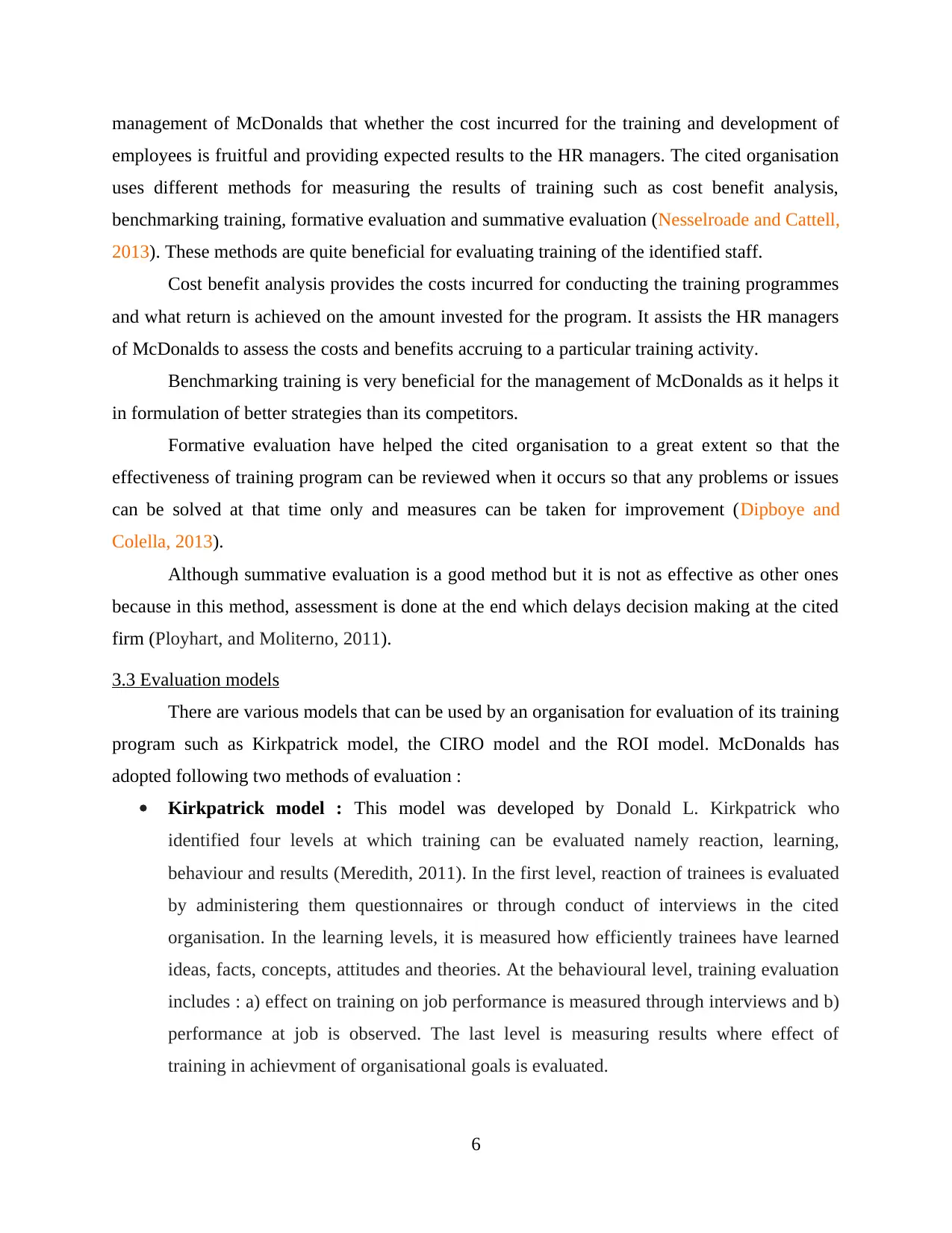
management of McDonalds that whether the cost incurred for the training and development of
employees is fruitful and providing expected results to the HR managers. The cited organisation
uses different methods for measuring the results of training such as cost benefit analysis,
benchmarking training, formative evaluation and summative evaluation (Nesselroade and Cattell,
2013). These methods are quite beneficial for evaluating training of the identified staff.
Cost benefit analysis provides the costs incurred for conducting the training programmes
and what return is achieved on the amount invested for the program. It assists the HR managers
of McDonalds to assess the costs and benefits accruing to a particular training activity.
Benchmarking training is very beneficial for the management of McDonalds as it helps it
in formulation of better strategies than its competitors.
Formative evaluation have helped the cited organisation to a great extent so that the
effectiveness of training program can be reviewed when it occurs so that any problems or issues
can be solved at that time only and measures can be taken for improvement (Dipboye and
Colella, 2013).
Although summative evaluation is a good method but it is not as effective as other ones
because in this method, assessment is done at the end which delays decision making at the cited
firm (Ployhart, and Moliterno, 2011).
3.3 Evaluation models
There are various models that can be used by an organisation for evaluation of its training
program such as Kirkpatrick model, the CIRO model and the ROI model. McDonalds has
adopted following two methods of evaluation :
Kirkpatrick model : This model was developed by Donald L. Kirkpatrick who
identified four levels at which training can be evaluated namely reaction, learning,
behaviour and results (Meredith, 2011). In the first level, reaction of trainees is evaluated
by administering them questionnaires or through conduct of interviews in the cited
organisation. In the learning levels, it is measured how efficiently trainees have learned
ideas, facts, concepts, attitudes and theories. At the behavioural level, training evaluation
includes : a) effect on training on job performance is measured through interviews and b)
performance at job is observed. The last level is measuring results where effect of
training in achievment of organisational goals is evaluated.
6
employees is fruitful and providing expected results to the HR managers. The cited organisation
uses different methods for measuring the results of training such as cost benefit analysis,
benchmarking training, formative evaluation and summative evaluation (Nesselroade and Cattell,
2013). These methods are quite beneficial for evaluating training of the identified staff.
Cost benefit analysis provides the costs incurred for conducting the training programmes
and what return is achieved on the amount invested for the program. It assists the HR managers
of McDonalds to assess the costs and benefits accruing to a particular training activity.
Benchmarking training is very beneficial for the management of McDonalds as it helps it
in formulation of better strategies than its competitors.
Formative evaluation have helped the cited organisation to a great extent so that the
effectiveness of training program can be reviewed when it occurs so that any problems or issues
can be solved at that time only and measures can be taken for improvement (Dipboye and
Colella, 2013).
Although summative evaluation is a good method but it is not as effective as other ones
because in this method, assessment is done at the end which delays decision making at the cited
firm (Ployhart, and Moliterno, 2011).
3.3 Evaluation models
There are various models that can be used by an organisation for evaluation of its training
program such as Kirkpatrick model, the CIRO model and the ROI model. McDonalds has
adopted following two methods of evaluation :
Kirkpatrick model : This model was developed by Donald L. Kirkpatrick who
identified four levels at which training can be evaluated namely reaction, learning,
behaviour and results (Meredith, 2011). In the first level, reaction of trainees is evaluated
by administering them questionnaires or through conduct of interviews in the cited
organisation. In the learning levels, it is measured how efficiently trainees have learned
ideas, facts, concepts, attitudes and theories. At the behavioural level, training evaluation
includes : a) effect on training on job performance is measured through interviews and b)
performance at job is observed. The last level is measuring results where effect of
training in achievment of organisational goals is evaluated.
6
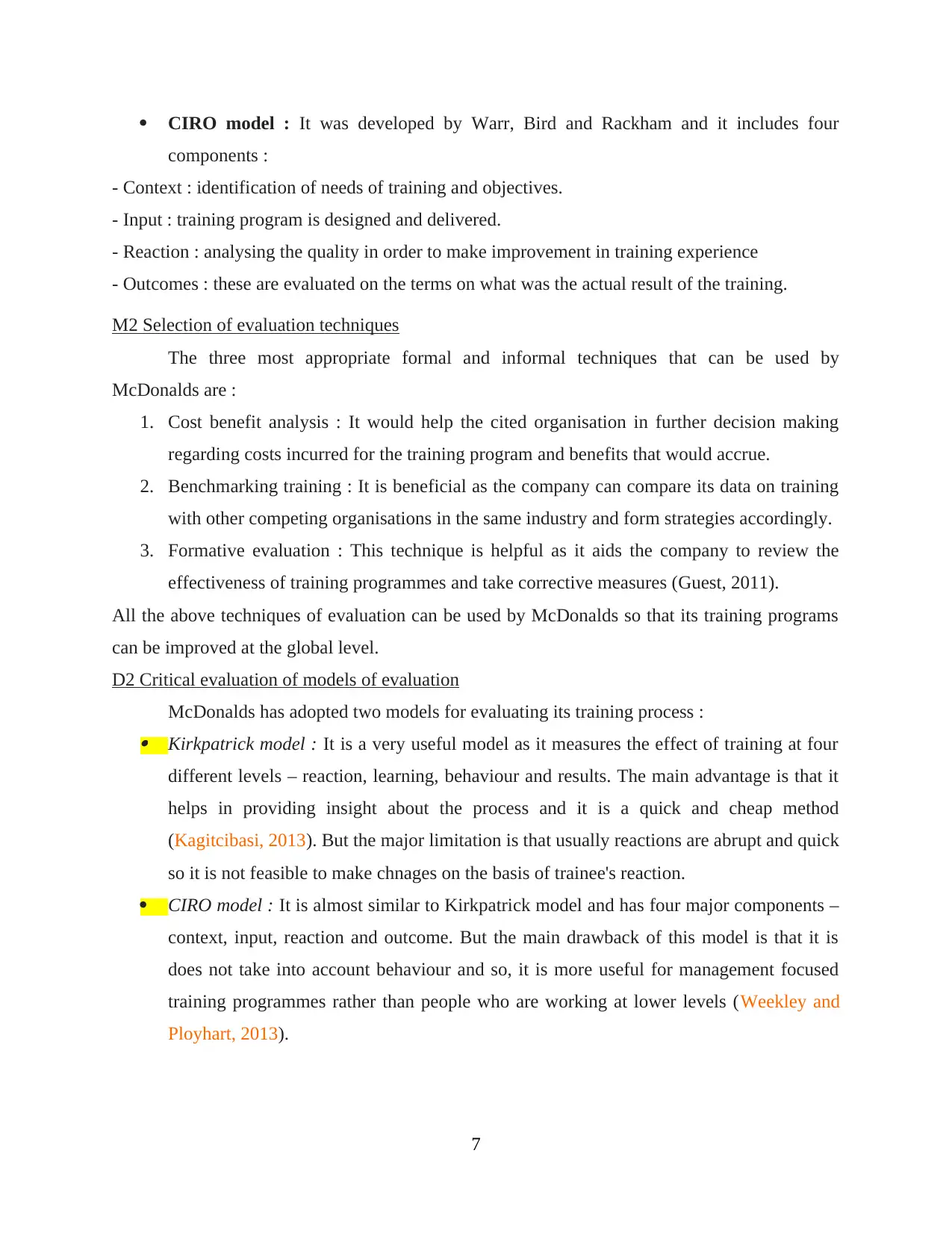
CIRO model : It was developed by Warr, Bird and Rackham and it includes four
components :
- Context : identification of needs of training and objectives.
- Input : training program is designed and delivered.
- Reaction : analysing the quality in order to make improvement in training experience
- Outcomes : these are evaluated on the terms on what was the actual result of the training.
M2 Selection of evaluation techniques
The three most appropriate formal and informal techniques that can be used by
McDonalds are :
1. Cost benefit analysis : It would help the cited organisation in further decision making
regarding costs incurred for the training program and benefits that would accrue.
2. Benchmarking training : It is beneficial as the company can compare its data on training
with other competing organisations in the same industry and form strategies accordingly.
3. Formative evaluation : This technique is helpful as it aids the company to review the
effectiveness of training programmes and take corrective measures (Guest, 2011).
All the above techniques of evaluation can be used by McDonalds so that its training programs
can be improved at the global level.
D2 Critical evaluation of models of evaluation
McDonalds has adopted two models for evaluating its training process : Kirkpatrick model : It is a very useful model as it measures the effect of training at four
different levels – reaction, learning, behaviour and results. The main advantage is that it
helps in providing insight about the process and it is a quick and cheap method
(Kagitcibasi, 2013). But the major limitation is that usually reactions are abrupt and quick
so it is not feasible to make chnages on the basis of trainee's reaction.
CIRO model : It is almost similar to Kirkpatrick model and has four major components –
context, input, reaction and outcome. But the main drawback of this model is that it is
does not take into account behaviour and so, it is more useful for management focused
training programmes rather than people who are working at lower levels (Weekley and
Ployhart, 2013).
7
components :
- Context : identification of needs of training and objectives.
- Input : training program is designed and delivered.
- Reaction : analysing the quality in order to make improvement in training experience
- Outcomes : these are evaluated on the terms on what was the actual result of the training.
M2 Selection of evaluation techniques
The three most appropriate formal and informal techniques that can be used by
McDonalds are :
1. Cost benefit analysis : It would help the cited organisation in further decision making
regarding costs incurred for the training program and benefits that would accrue.
2. Benchmarking training : It is beneficial as the company can compare its data on training
with other competing organisations in the same industry and form strategies accordingly.
3. Formative evaluation : This technique is helpful as it aids the company to review the
effectiveness of training programmes and take corrective measures (Guest, 2011).
All the above techniques of evaluation can be used by McDonalds so that its training programs
can be improved at the global level.
D2 Critical evaluation of models of evaluation
McDonalds has adopted two models for evaluating its training process : Kirkpatrick model : It is a very useful model as it measures the effect of training at four
different levels – reaction, learning, behaviour and results. The main advantage is that it
helps in providing insight about the process and it is a quick and cheap method
(Kagitcibasi, 2013). But the major limitation is that usually reactions are abrupt and quick
so it is not feasible to make chnages on the basis of trainee's reaction.
CIRO model : It is almost similar to Kirkpatrick model and has four major components –
context, input, reaction and outcome. But the main drawback of this model is that it is
does not take into account behaviour and so, it is more useful for management focused
training programmes rather than people who are working at lower levels (Weekley and
Ployhart, 2013).
7
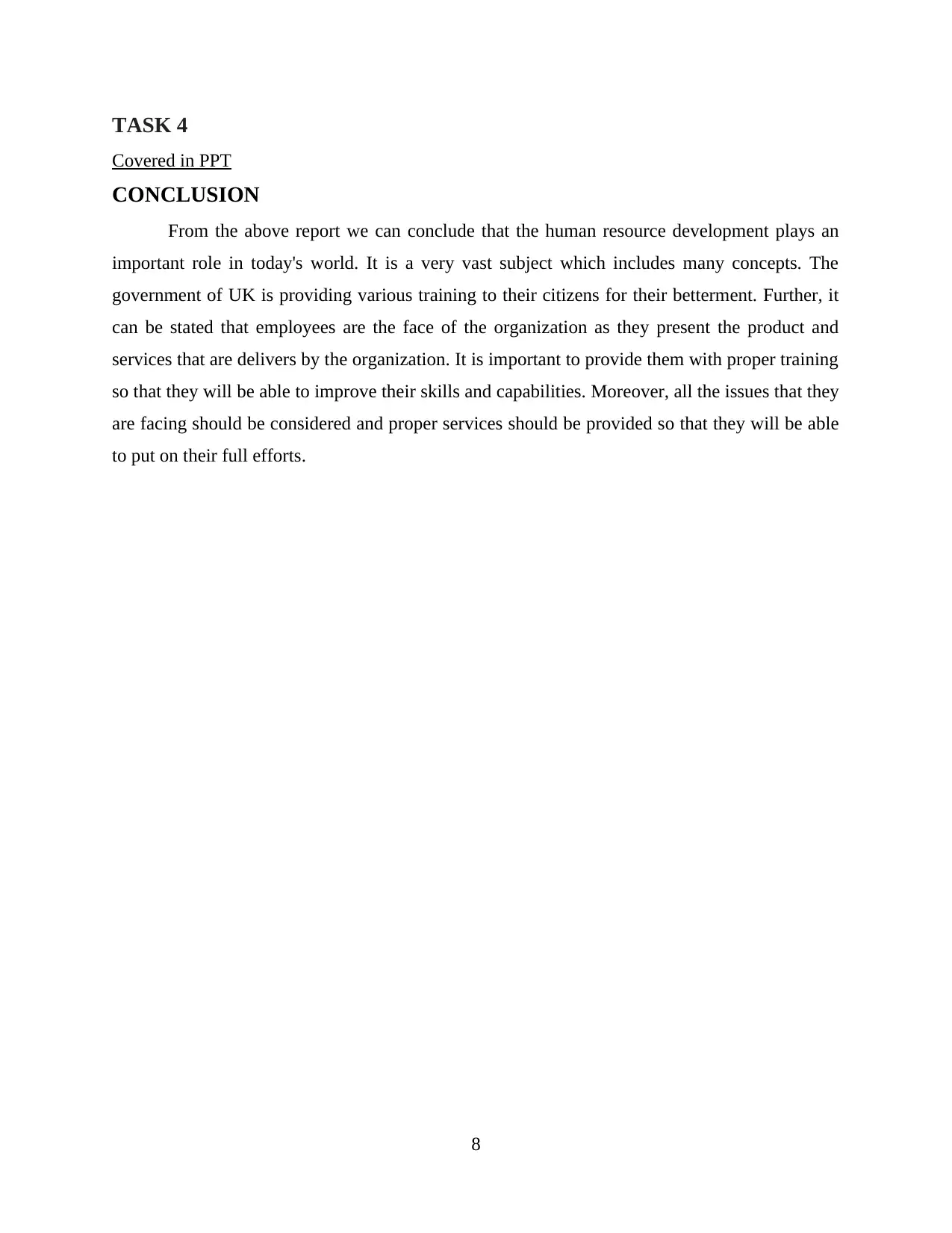
TASK 4
Covered in PPT
CONCLUSION
From the above report we can conclude that the human resource development plays an
important role in today's world. It is a very vast subject which includes many concepts. The
government of UK is providing various training to their citizens for their betterment. Further, it
can be stated that employees are the face of the organization as they present the product and
services that are delivers by the organization. It is important to provide them with proper training
so that they will be able to improve their skills and capabilities. Moreover, all the issues that they
are facing should be considered and proper services should be provided so that they will be able
to put on their full efforts.
8
Covered in PPT
CONCLUSION
From the above report we can conclude that the human resource development plays an
important role in today's world. It is a very vast subject which includes many concepts. The
government of UK is providing various training to their citizens for their betterment. Further, it
can be stated that employees are the face of the organization as they present the product and
services that are delivers by the organization. It is important to provide them with proper training
so that they will be able to improve their skills and capabilities. Moreover, all the issues that they
are facing should be considered and proper services should be provided so that they will be able
to put on their full efforts.
8
Secure Best Marks with AI Grader
Need help grading? Try our AI Grader for instant feedback on your assignments.
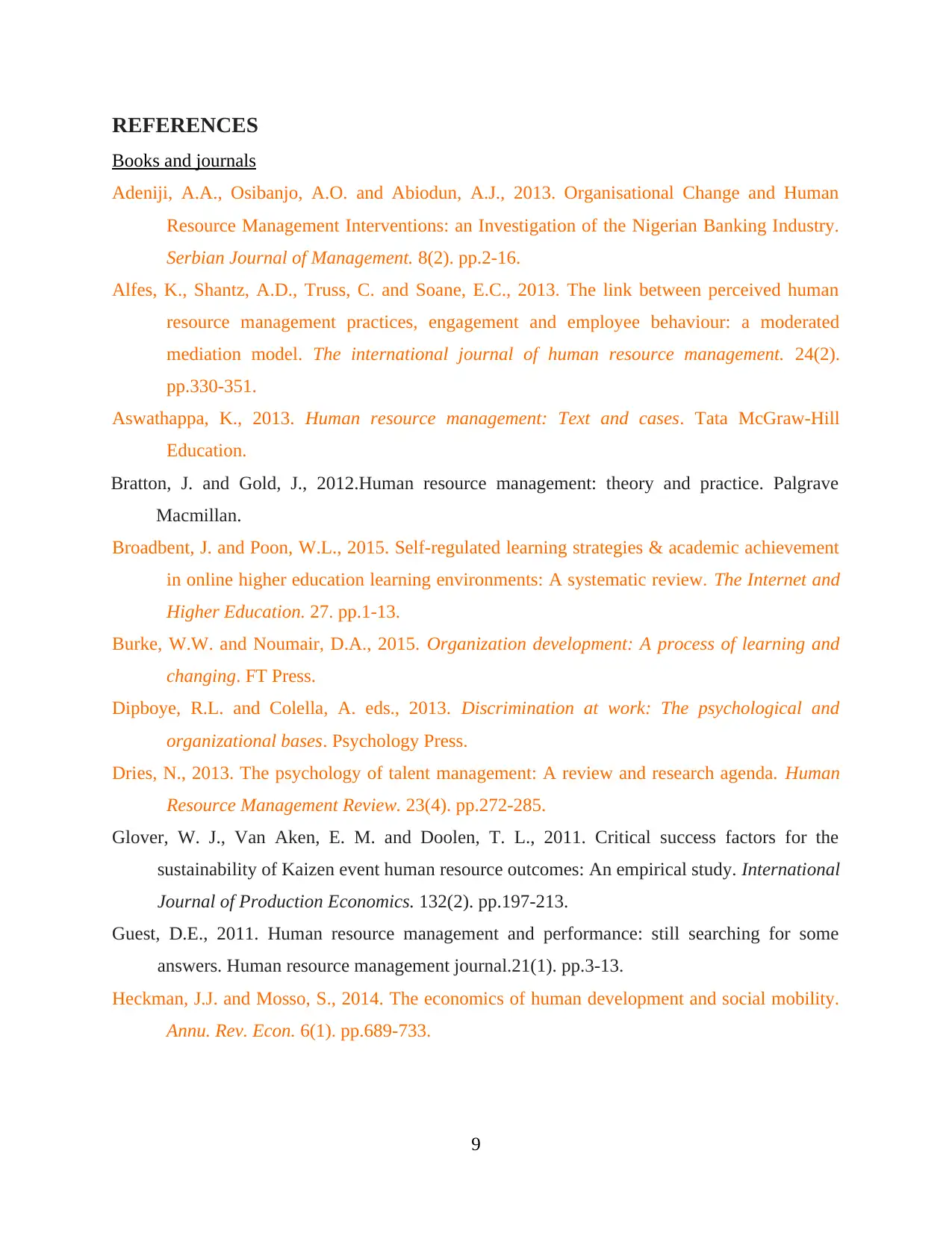
REFERENCES
Books and journals
Adeniji, A.A., Osibanjo, A.O. and Abiodun, A.J., 2013. Organisational Change and Human
Resource Management Interventions: an Investigation of the Nigerian Banking Industry.
Serbian Journal of Management. 8(2). pp.2-16.
Alfes, K., Shantz, A.D., Truss, C. and Soane, E.C., 2013. The link between perceived human
resource management practices, engagement and employee behaviour: a moderated
mediation model. The international journal of human resource management. 24(2).
pp.330-351.
Aswathappa, K., 2013. Human resource management: Text and cases. Tata McGraw-Hill
Education.
Bratton, J. and Gold, J., 2012.Human resource management: theory and practice. Palgrave
Macmillan.
Broadbent, J. and Poon, W.L., 2015. Self-regulated learning strategies & academic achievement
in online higher education learning environments: A systematic review. The Internet and
Higher Education. 27. pp.1-13.
Burke, W.W. and Noumair, D.A., 2015. Organization development: A process of learning and
changing. FT Press.
Dipboye, R.L. and Colella, A. eds., 2013. Discrimination at work: The psychological and
organizational bases. Psychology Press.
Dries, N., 2013. The psychology of talent management: A review and research agenda. Human
Resource Management Review. 23(4). pp.272-285.
Glover, W. J., Van Aken, E. M. and Doolen, T. L., 2011. Critical success factors for the
sustainability of Kaizen event human resource outcomes: An empirical study. International
Journal of Production Economics. 132(2). pp.197-213.
Guest, D.E., 2011. Human resource management and performance: still searching for some
answers. Human resource management journal.21(1). pp.3-13.
Heckman, J.J. and Mosso, S., 2014. The economics of human development and social mobility.
Annu. Rev. Econ. 6(1). pp.689-733.
9
Books and journals
Adeniji, A.A., Osibanjo, A.O. and Abiodun, A.J., 2013. Organisational Change and Human
Resource Management Interventions: an Investigation of the Nigerian Banking Industry.
Serbian Journal of Management. 8(2). pp.2-16.
Alfes, K., Shantz, A.D., Truss, C. and Soane, E.C., 2013. The link between perceived human
resource management practices, engagement and employee behaviour: a moderated
mediation model. The international journal of human resource management. 24(2).
pp.330-351.
Aswathappa, K., 2013. Human resource management: Text and cases. Tata McGraw-Hill
Education.
Bratton, J. and Gold, J., 2012.Human resource management: theory and practice. Palgrave
Macmillan.
Broadbent, J. and Poon, W.L., 2015. Self-regulated learning strategies & academic achievement
in online higher education learning environments: A systematic review. The Internet and
Higher Education. 27. pp.1-13.
Burke, W.W. and Noumair, D.A., 2015. Organization development: A process of learning and
changing. FT Press.
Dipboye, R.L. and Colella, A. eds., 2013. Discrimination at work: The psychological and
organizational bases. Psychology Press.
Dries, N., 2013. The psychology of talent management: A review and research agenda. Human
Resource Management Review. 23(4). pp.272-285.
Glover, W. J., Van Aken, E. M. and Doolen, T. L., 2011. Critical success factors for the
sustainability of Kaizen event human resource outcomes: An empirical study. International
Journal of Production Economics. 132(2). pp.197-213.
Guest, D.E., 2011. Human resource management and performance: still searching for some
answers. Human resource management journal.21(1). pp.3-13.
Heckman, J.J. and Mosso, S., 2014. The economics of human development and social mobility.
Annu. Rev. Econ. 6(1). pp.689-733.
9
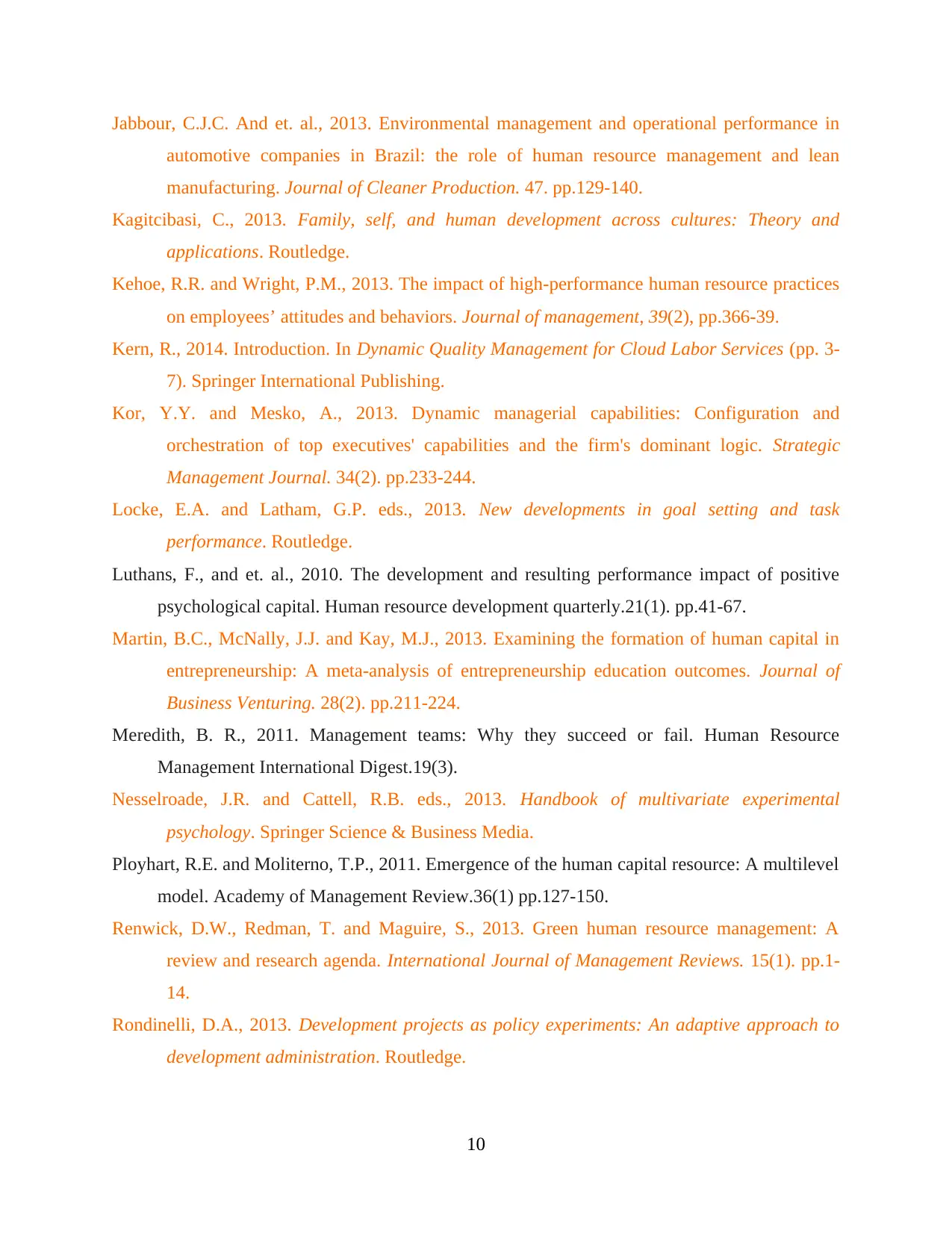
Jabbour, C.J.C. And et. al., 2013. Environmental management and operational performance in
automotive companies in Brazil: the role of human resource management and lean
manufacturing. Journal of Cleaner Production. 47. pp.129-140.
Kagitcibasi, C., 2013. Family, self, and human development across cultures: Theory and
applications. Routledge.
Kehoe, R.R. and Wright, P.M., 2013. The impact of high-performance human resource practices
on employees’ attitudes and behaviors. Journal of management, 39(2), pp.366-39.
Kern, R., 2014. Introduction. In Dynamic Quality Management for Cloud Labor Services (pp. 3-
7). Springer International Publishing.
Kor, Y.Y. and Mesko, A., 2013. Dynamic managerial capabilities: Configuration and
orchestration of top executives' capabilities and the firm's dominant logic. Strategic
Management Journal. 34(2). pp.233-244.
Locke, E.A. and Latham, G.P. eds., 2013. New developments in goal setting and task
performance. Routledge.
Luthans, F., and et. al., 2010. The development and resulting performance impact of positive
psychological capital. Human resource development quarterly.21(1). pp.41-67.
Martin, B.C., McNally, J.J. and Kay, M.J., 2013. Examining the formation of human capital in
entrepreneurship: A meta-analysis of entrepreneurship education outcomes. Journal of
Business Venturing. 28(2). pp.211-224.
Meredith, B. R., 2011. Management teams: Why they succeed or fail. Human Resource
Management International Digest.19(3).
Nesselroade, J.R. and Cattell, R.B. eds., 2013. Handbook of multivariate experimental
psychology. Springer Science & Business Media.
Ployhart, R.E. and Moliterno, T.P., 2011. Emergence of the human capital resource: A multilevel
model. Academy of Management Review.36(1) pp.127-150.
Renwick, D.W., Redman, T. and Maguire, S., 2013. Green human resource management: A
review and research agenda. International Journal of Management Reviews. 15(1). pp.1-
14.
Rondinelli, D.A., 2013. Development projects as policy experiments: An adaptive approach to
development administration. Routledge.
10
automotive companies in Brazil: the role of human resource management and lean
manufacturing. Journal of Cleaner Production. 47. pp.129-140.
Kagitcibasi, C., 2013. Family, self, and human development across cultures: Theory and
applications. Routledge.
Kehoe, R.R. and Wright, P.M., 2013. The impact of high-performance human resource practices
on employees’ attitudes and behaviors. Journal of management, 39(2), pp.366-39.
Kern, R., 2014. Introduction. In Dynamic Quality Management for Cloud Labor Services (pp. 3-
7). Springer International Publishing.
Kor, Y.Y. and Mesko, A., 2013. Dynamic managerial capabilities: Configuration and
orchestration of top executives' capabilities and the firm's dominant logic. Strategic
Management Journal. 34(2). pp.233-244.
Locke, E.A. and Latham, G.P. eds., 2013. New developments in goal setting and task
performance. Routledge.
Luthans, F., and et. al., 2010. The development and resulting performance impact of positive
psychological capital. Human resource development quarterly.21(1). pp.41-67.
Martin, B.C., McNally, J.J. and Kay, M.J., 2013. Examining the formation of human capital in
entrepreneurship: A meta-analysis of entrepreneurship education outcomes. Journal of
Business Venturing. 28(2). pp.211-224.
Meredith, B. R., 2011. Management teams: Why they succeed or fail. Human Resource
Management International Digest.19(3).
Nesselroade, J.R. and Cattell, R.B. eds., 2013. Handbook of multivariate experimental
psychology. Springer Science & Business Media.
Ployhart, R.E. and Moliterno, T.P., 2011. Emergence of the human capital resource: A multilevel
model. Academy of Management Review.36(1) pp.127-150.
Renwick, D.W., Redman, T. and Maguire, S., 2013. Green human resource management: A
review and research agenda. International Journal of Management Reviews. 15(1). pp.1-
14.
Rondinelli, D.A., 2013. Development projects as policy experiments: An adaptive approach to
development administration. Routledge.
10

Slavić, A., Berber, N. and Leković, B., 2014. Performance management in international human
resource management: evidence from the CEE region. Serbian Journal of Management.
9(1). pp.45-58.
Weekley, J.A. and Ployhart, R.E. eds., 2013. Situational judgment tests: Theory, measurement,
and application. Psychology Press.
Zimmerman, T., Gavrilova-Aguilar, M. and Cullum, P., 2013. Rethinking human resource
strategies: A shift in the treatment of contingent workers. International Journal of
Business and Management. 8(7). pp.28-34.
11
resource management: evidence from the CEE region. Serbian Journal of Management.
9(1). pp.45-58.
Weekley, J.A. and Ployhart, R.E. eds., 2013. Situational judgment tests: Theory, measurement,
and application. Psychology Press.
Zimmerman, T., Gavrilova-Aguilar, M. and Cullum, P., 2013. Rethinking human resource
strategies: A shift in the treatment of contingent workers. International Journal of
Business and Management. 8(7). pp.28-34.
11
1 out of 13
Related Documents
Your All-in-One AI-Powered Toolkit for Academic Success.
+13062052269
info@desklib.com
Available 24*7 on WhatsApp / Email
![[object Object]](/_next/static/media/star-bottom.7253800d.svg)
Unlock your academic potential
© 2024 | Zucol Services PVT LTD | All rights reserved.





